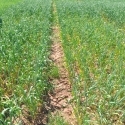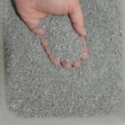13 Feb 2011
What sulphur source should I use?
Discussion of the various sources of S for crops and pastures.
SULPHUR (S) has been recognized as restricting crop and pasture production in many parts of the Australia. Soil S budgets are negative in many areas, where more S is removed from the field in harvested crops than is supplied by various inputs.
Much of the S in soil is present in organic matter, where it is unavailable for plant uptake until it is converted to sulphate. Plants require adequate S for many reactions, including synthesis of proteins and enzymes.
When additional S is needed to meet crop needs, there are many excellent sources of this nutrient.
Elemental S was once mined directly from the earth. It is now more typically obtained from coal, crude oil, and natural gas during refining or during scrubbing of combustion gases. A number of common earth minerals are also used as S sources for agriculture.
Elemental S is not water soluble and must be oxidized by soil bacteria to sulphate (SO42-) before it can be taken up by plant roots. The speed of this microbial process is governed by environmental factors such as soil temperature and moisture, as well as the physical properties of the S.
Various approaches have been used to enhance the conversion of elemental S to plant-available sulphate. The speed of elemental S oxidation is directly related to the particle size, where smaller particles have a greater surface area for the soil bacteria to act on. Therefore, large particles of S may require months or years of biological action before oxidizing significant amounts of sulphate. Fine, dust-sized particles are oxidized quickly, but are not easy to apply.
One approach to enhance the rate of S oxidation is to add a small amount of clay to the molten S prior to cooling and forming small pellets (“pastilles”). When added to soil, the clay swells with water and the pastille disintegrates into fine particles that are rapidly oxidized.
Very thin layers of elemental S can be incorporated during fertilizer granule manufacturing. This S is
quick to oxidize and become available for plant uptake. This reaction can have a positive impact on the plant availability of some micronutrients, such as zinc and iron, which become more soluble as the pH declines. Finely ground elemental S is sometimes added to fertilizer suspensions. Elemental S is also used as a fungicide for crop protection.
Elemental S and sulphuric acid are commonly used in the reclamation of calcareous soils that contain elevated sodium and in the treatment of irrigation water containing excessive bicarbonate.
A number of excellent soluble sulphate fertilizers are available to provide a rapid supply of nutrients. The selection of a particular soluble material depends on price, availability, form, and the other nutrients that accompany the sulfate. A few examples of commonly used S fertilizers include:
· Non-Soluble – Elemental S
· Semi-Soluble – Gypsum (15 to 17% S)
· Soluble – Ammonium sulfate (24% S); Epsom salt (13%); Kieserite (23% S);
Langbeinite (22% S); Potassium sulfate (18% S); Thiosulfate (10 to 26% S)
For more information, contact either
Dr. Rob Norton, IPNI Australia and New Zealand, 54 Florence St, Horsham, Victoria, 3400. rnorton@ipni.net.
Or
Dr Robert Mikkelsen, Western North America Director, IPNI, 4125 Sattui Court,
Merced, CA 95348. rmikkelsen@ipni.net.




